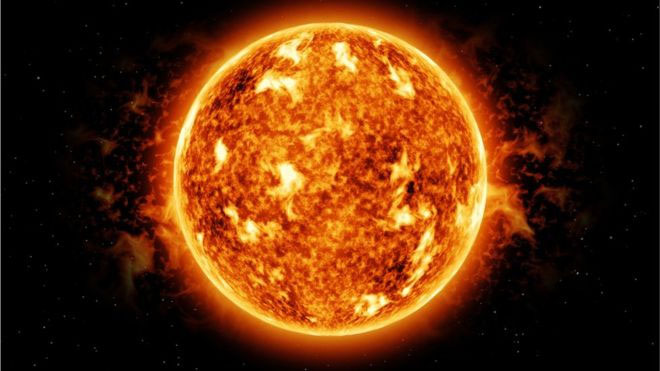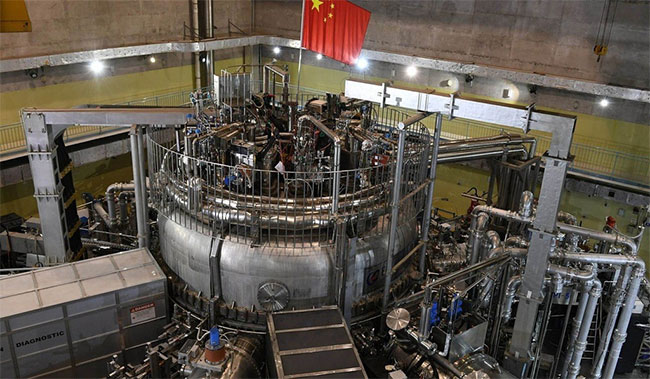When do we have the artificial Sun?
Fusion energy seems like a promising and promising technology, but never true?
People are always looking for cheaper and cleaner sources of energy, but those two concepts don't usually go together. Fossil energy is cheap but polluting, high-cost and low-cost renewable energy, and nuclear energy has a radiation risk.
Therefore, the search for an endless source of energy at low cost is always a human dream. We can already imagine that dream with fusion or fusion technology , how the sun is generating energy, but this technology is not ready.

The thermonuclear reaction is the one that takes place in the core of the Sun and has been providing energy to the Earth for billions of years.(Photo: Getty).
How to create energy like the Sun
Inside the core of the Sun exists a "nuclear reactor" . Different from the principle of the current nuclear furnaces on Earth that uses fission, a chain of reactions that splits uranium atoms to release energy; the process that takes place in the core of the Sun is a fusion reaction that does the opposite of fusing atoms together.
When two hydrogen nuclei fuse together to become helium, they create a huge source of energy. This process is called fusion or fusion. This reaction generates all the energy, including the light and heat of the Sun.

Scientists will have to create environments with extremely high temperatures and pressures, while also controlling the output of the energy generated from the reaction.(Photo: Xinhua).
If the reaction is likely to be carried out in a laboratory, it can provide almost infinite base load power with almost zero carbon emissions. The easiest way that can be done in a lab is the fusion of two different hydrogen isotopes: deuterium and tritium. The product of the reaction is helium and neutron ions. Most previous studies of thermonuclear reactions followed this reaction.
The deuterium-tritium fusion works best at temperatures of 100,000,000 degrees Celsius. Superconducting coils are used to create a magnetic field about 1 million times stronger than the Earth's. out the plasma. The problem with current fusion reaction experiments is that the energy to create and maintain the reaction is greater than the energy gained.
The next phase of the study will involve an experiment called ITER under construction in southern France. At the ITER reactor, the heat generated from the reaction is equal to the temperature provided for activation. In theory, this could create a residual energy source. In the past, the most efficient fusion reactor produced only 67% of the energy supplied.
New direction of the scientific world
A number of recently published studies show that researchers are looking for a different direction for fusion reactions. Theoretical physicist Heinrich Hora and colleagues at the University of New South Wales have patented a new technology, instead of using hydrogen isotopes that combine hydrogen and boron atoms. Specifically, they will use powerful lasers to create a magnetic field and a second laser to heat hydrogen - boron fuel in order to reach the fusion ignition point.
When a hydrogen nucleus (a single proton) combines with a boron-11 nucleus, it creates three helium-containing nuclei. Compared to deuterium-tritium reaction, this way has the advantage of not producing any neutron particles. Neutron storage generated from fusion is still challenging.

The challenge of laser activation reactions is the accuracy and stability of the laser.(Photo: Lawrence Livermore National Laboratory).
However, the hydrogen - boron reaction is difficult to activate. Hora's solution was to use a laser to heat a small pellet to ignition temperature and another laser to heat a metal coil to create a magnetic field containing the plasma. They must use very short laser pulses, only a few nanoseconds. The magnetic field of the hydrogen - boson reactor must be about 1,000 times the deuterium - tritium reaction.
Hora and his colleagues stated that their process would produce an 'avalanche' effect in the fuel pellet, which meant more fusion reactions than expected. The team said they could create a stable fusion reactor within the next five years. However, according to Science Alert, this forecast is somewhat optimistic.
There have been many organizations around the world trying to complete this process. For example, the US Energy Agency has tested using 192 laser beams on a small target and close to the reaction trigger conditions. However, they have not been able to precisely control the laser beam angle, the beam's stability. These are variables that make the reaction incomplete.
If put into use, a power plant will have to perform laser projection 10 times / second. Meanwhile, the new trials reach frequency at most 2 times / day.
Today, the biggest hope for fusion energy is the ITER project, a multinational cooperative effort. This reactor has a total budget of 22 billion USD, and is currently about 65% complete. ITER will be operational by 2025.
- This is the newly created "Sun" in the US
- Germany tests "world's largest artificial sun"
- Successfully developed an artificial arm that can feel real
- Artificial meat $ 330,000 to the oven
- Successfully developing artificial muscles like real ones, being able to reproduce themselves
- What is Artificial Intelligence? What is AI (artificial intelligence)?
- What do people do with discarded artificial grass?
- For the first time there was a banquet with artificial meat
- UAE built artificial mountains to increase rainwater
- Artificial brains are capable of counting and reasoning
- Artificial creatures 'eat' CO2
- Launched the first manual manual for artificial food processing
- Coming soon the world's first cheap artificial beef cake
- Japanese scientists successfully tested artificial blood on rabbits
 'Fine laughs' - Scary and painful torture in ancient times
'Fine laughs' - Scary and painful torture in ancient times The sequence of numbers 142857 of the Egyptian pyramids is known as the strangest number in the world - Why?
The sequence of numbers 142857 of the Egyptian pyramids is known as the strangest number in the world - Why? History of the iron
History of the iron What is alum?
What is alum?